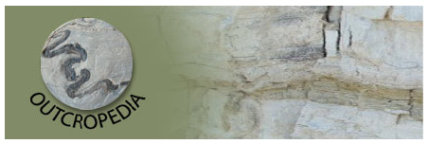Folds caused by gravitational gliding in unconsolidated and soft-sediments are called slump folds. They can form by layer-parallel shear. Such folds reflect the orientation of the palaeoslope in ancient settings. PhotoID799
The photograph was taken from the road section of Eocene Karaj Formation, near Karaj city (with a view to the WNW), 35° 50´ 11˝N, 51° 02´ 40˝E. Karaj Formation, ~ 3300 m thick, mainly composed of a heterogeneous assemblage of green tuff and tuffite, thin bands of marine shale, and igneous rocks. The thick turbidites with slump folding in the Karaj Formation may indicate a relatively deep water through and submarine fan. The Z-shaped asymmetric and overturned slump fold indicate northward palaeoslope. These conditions show stage 3 geometries (late translation of slump) of formation and develop of slump fold system by surging flow with flow accelerates and contraction increases downslope.
Folds caused by gravitational gliding in unconsolidated and soft-sediments are called slump folds. They can form by layer-parallel shear. Such folds reflect the orientation of the palaeoslope in ancient settings. PhotoID799
The photograph was taken from the road section of Eocene Karaj Formation, near Karaj city (with a view to the WNW), 35° 50´ 11˝N, 51° 02´ 40˝E. Karaj Formation, ~ 3300 m thick, mainly composed of a heterogeneous assemblage of green tuff and tuffite, thin bands of marine shale, and igneous rocks. The thick turbidites with slump folding in the Karaj Formation may indicate a relatively deep water through and submarine fan. The Z-shaped asymmetric and overturned slump fold indicate northward palaeoslope. These conditions show stage 3 geometries (late translation of slump) of formation and develop of slump fold system by surging flow with flow accelerates and contraction increases downslope.
Photograph: Seyed Tohid Nabavi
